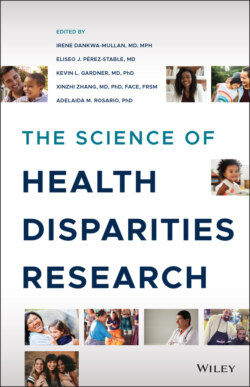Читать книгу The Science of Health Disparities Research - Группа авторов - Страница 77
4.5 Challenges and Future Opportunities
ОглавлениеIn the twentieth century, Americans witnessed an increase in life expectancy of 30 years, 80% of which can be attributed to public health advances [40]. These included reducing the rate of adult tobacco use by half, improving food safety and nutrition, broadening access to clean water and improving sanitation, eradicating smallpox and creating and using vaccines against other infectious diseases, and making family planning methods accessible and effective [41]. What we learn from this, and even more from the statistics indicating how far from good health our behaviors take us as well as the cost of treatment, is that “the potential of behavioral and social interventions for increasing life expectancy may be orders of magnitude greater than traditional medical interventions” [2].
In the twenty‐first century, chronic disease has been identified as the predominant emerging challenge to global health [42]. It is a growing challenge in the United States and in subpopulations characterized by health disparities. Chronic conditions, which are responsible for most ill health, disability, and death as well as most of the cost of healthcare in the United States [43], represent 7 of the top 10 causes of death—6 of which have related behavioral determinants—and are responsible for about 75% of all deaths [11]. Heart disease is first on the list of chronic conditions. Rates for hypertension are highest in non‐Latino Blacks (43.3%) and lowest in non‐Latino Asians (26.5%). Years lost under age 75 per 100 000 population because of diabetes (seventh on the list) is 321 per 100 000 non‐Latino Blacks. The rate for non‐Latino Asians is 4.3 times lower (74 years/100 000). Though healthcare spending since 1960 has outpaced the growth of the gross domestic product fivefold [44], the United States has little to show for it. While ranking as the biggest global healthcare spender, it posts a life expectancy that puts it behind 25 other countries [43].
Not unlike understanding biological pathways in disease, understanding how an individual's interaction with his/her environment can result in chronic disease can help researchers identify and prevent social and behavioral determinants of chronic disease. Multidisciplinary investigators at Michigan State University and Washington State University investigated ways to jumpstart physical activity and more healthful eating in Flint, Michigan, and began a search for successful hypertension interventions that could work with American Indians, Pacific Islanders, and Alaska Natives in the Pacific Northwest [45].
In Michigan, Vicki Johnson‐Lawrence, PhD, and other investigators working in part on evidence that Blacks, Latinos, and women of lower socioeconomic position are at greater risk of obesity [46], conceived a multilevel—individual, community, and structural—approach to reduce obesity and cardiovascular disease. Investigators believe economically disadvantaged communities need interventions that work on multiple levels to produce complementary, sustainable, longitudinal results. In Flint, a community already dealing with a lead‐contaminated water supply [47], the county health department partnered with local churches to devise an intervention incorporating classes in cooking and African American dietary history, peer support, and church‐based food pantry access. The pursuit of environmental policy goals, including health‐positive land use (e.g., making way for grocery stores with fresh food and creating bike lanes and sidewalks), is part of an effort that will involve educational institutions, government, community organizations, and individuals.
In Washington, Dedra Buchwald, MD, and colleagues are working with American Indians, who are prone to strokes at younger ages and are three times more likely to die of a stroke if it occurs before they turn 65. These investigators are addressing blood pressure control to reduce cardiovascular disease and stroke. Health team members who work with these populations rely on technology at hand—grocery shopping applications, text messaging, and patient‐friendly blood pressure and physical activity monitors—to increase activity, improve diet, and monitor and prevent cardiovascular events.
Working under the umbrella of the Transdisciplinary Collaborative Centers for Health Disparities Research on Chronic Disease Prevention program, funded by National Institute on Minority Health and Health Disparities (NIMHD), these and other researchers are undertaking multilevel investigations that will identify what works in these populations characterized by health disparities. They and others are seeking ways to control energy balance, reduce hypertension and cardiovascular disease, and solve other health problems affecting populations across the United States.
